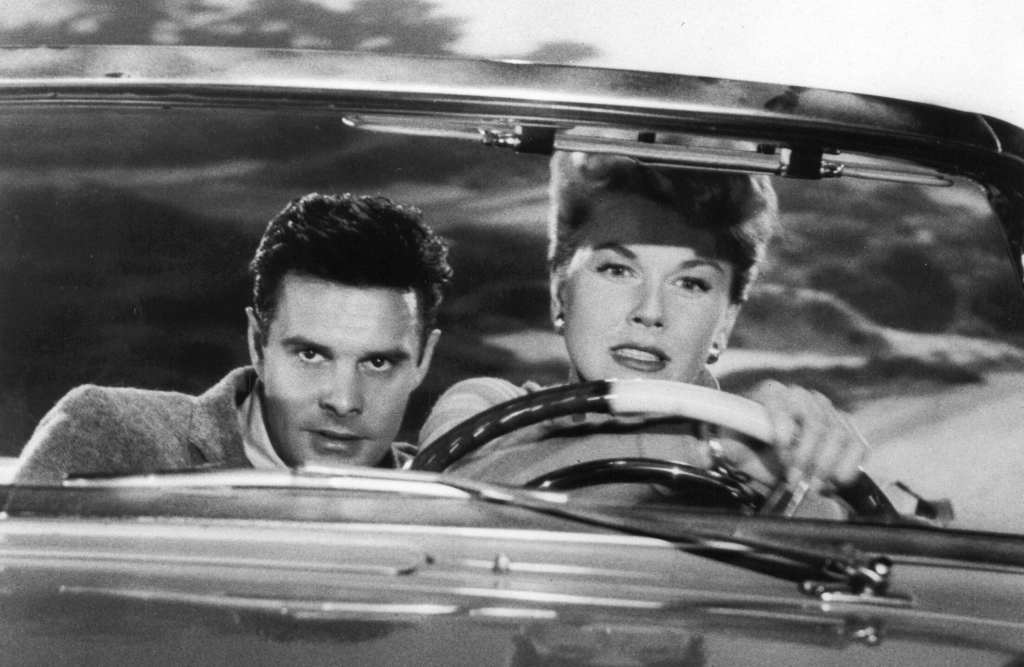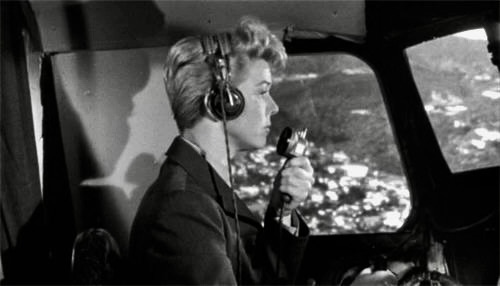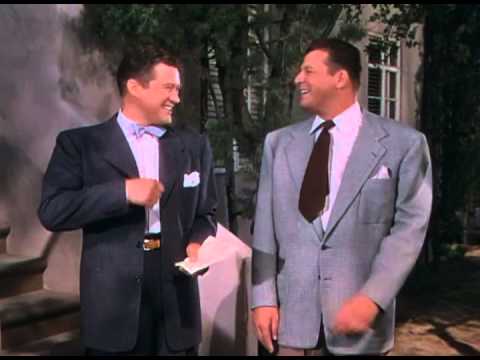Doris Day would have turned 100 today. For years, I thought for sure she was going to make it, so I was very sad when she passed away in 2019 at the age of 97. Doris seemed eternal–one of the last remaining major figures of the Golden Age of Hollywood. Her sunny persona and girl next door looks I think led to her being unfairly labeled as “virginal” or goody goody. I even had this same perception of her until I actually started watching her films. Yes, she does have some sugary sweet roles, but those are only a tiny part of her overall body of work. One such departure from this image is Doris’ turn as the titular character in Julie, produced in 1956.

For years, when shopping the Warner Archive 4/$44 DVD sale, I would see Julie listed among the list of titles for purchase. Warner Archive for the most part, uses the original poster art for their film cover. The poster asks the question: What happened to Julie on her honeymoon? After seeing this film listed again and again during the sales, I just had to know: what did happen to Julie on her honeymoon? Eventually I purchased the movie to find out the answer. To put it simply, what happens to Julie on her honeymoon is that her husband tries to kill her.
Julie opens with a particularly haunting title track, with Doris singing the melody. Back-up singers continue to sing “Julie” in an eerie manner. Julie is an uncomfortable, tension-filled film noir–one of Doris’ few forays into this genre or style of filmmaking. The film opens with Julie (Doris, obviously) and her new husband Lyle (Louis Jourdan) arguing. The widowed Julie has just remarried the handsome and talented concert pianist Lyle, after her first husband commits suicide due to financial issues. The newlyweds had been attending a function at the country club when they got into a heated argument. Upset, Julie climbs into her car and drives off; but before she can get away, Lyle climbs into her car and continues the argument.

To say that their marriage is not getting off to a good start would be an understatement. Lyle obviously has a screw loose which is indicative right off the bat when he slides over on the bench seat of the car and places his foot over Julie’s, causing her to continue to accelerate on the highway. She is careening all over the highway, nearly driving off the cliff on multiple occasions while trying to negotiate California’s curvy coastline. As Julie screams for him to stop and to not kill them both, Lyle finally relents by letting his foot off Julie’s, seizing control of the steering wheel, and bringing the car to a stop. Understandably, Julie is a complete wreck.

Lyle continues to show himself for the abusive monster that he is, manipulating Julie into forgiving him for his actions. He says that he only did what he did out of love and that he needs her to help him get over his extreme jealousy. Lyle is a creep and things do not get better for Julie. Meanwhile, Julie has been speaking with her first husband’s cousin, Cliff (Barry Sullivan). Cliff is not convinced that his brother committed suicide, and if he had, it wouldn’t have been due to financial issues as Cliff had offered his brother money. Hearing this, Lyle at first plays it cool and actually seems sympathetic, but that soon goes by the wayside. He grows tired of repeatedly hearing Julie wonder outloud what could have triggered her husband’s suicide and tells her to leave her marriage to him in the past.

Lyle continues to stalk Julie and Cliff throughout the film and eventually Cliff asks Julie, what if her husband hadn’t committed suicide? After all, Lyle was staying at their home when her husband died. The film culminates with a somewhat unbelievable scene in which flight attendant Julie is forced to take control of the plane’s cockpit to save the lives of the passengers onboard.
Overall, Julie is a very tense and interesting film. Louis Jourdan is terrifying. I like him much more in this film than I did in Gigi. What I find the scariest about Jourdan is that is portrayal of a jealous, hot-tempered spouse is that his portrayal is not too far off the mark. I could completely see someone acting in the way that he does in this film. Doris also found this movie nerve-wracking to make as the behavior of Jourdan was reminiscent of the abusive treatment she received at the hands of her first and second husbands. What I find fascinating about Jourdan and Doris’ performances in this film is that off-screen, they were friends and neighbors! I also like Barry Sullivan. He is never flashy, but he’s good and I find him interesting. He’s great in noir.

I wish that Doris had made more noir and grittier fare, because she was good in these types of roles. A year prior to Julie, Doris made Love Me or Leave Me where she played the real life Ruth Etting, a singer and dime-a-dance girl who just wants to make it in show business. She has to deal with her abusive manager/lover, James Cagney, who uses his position to make or break her career as a means to control her. Just before making Julie, Doris had appeared as a distraught mother whose son is kidnapped in Alfred Hitchcock’s 1956 remake of his 1934 film, The Man Who Knew Too Much. This role was also a departure for Doris who had to spend much of the film frantically looking for her child, but it did bring us her signature song, “Que Sera Sera.” In 1960, Doris would make her last dramatic film, Midnight Lace, where she plays a woman being terrorized on the telephone.
While Julie may not be the greatest film noir, nor is it even the best Doris Day film, it demonstrates that Doris Day was more than just a lightweight romantic lead and singer. She is excellent as a young woman who marries the wrong man, but has to keep her cool to survive. Later, it’s her calm demeanor that is needed to save the lives of dozens of passengers. If there was one thing that Doris Day was always good at, in every role she had, was being a calming presence on screen. Que Sera Sera. Whatever will be, will be.





























